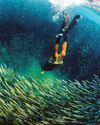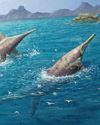
Roll up! Roll up! Get ready to take your seat for the greatest show on Earth. Imagine you’re flying through the air, juggling knives or breathing fire. Sound scary? Well, don’t worry – science has your back. We are looking at some of the most stunning feats, and how circus performers effortlessly use a knowledge of forces and other scientific know-how to amaze and entertain.
Nerves of steel
Circus acts have been performed for thousands of years, with juggling and acrobatics recorded in Egypt as far back as 2500BC. The ancient Romans and Greeks had funambulists, or rope dancers, where performers would represent famous characters while balancing on a tightrope, but how do these jumps, tricks and acrobatics work?
The everyday job of a tightrope walker involves being high up, with just a thin piece of cable between you and the ground. It’s a long way down, and the slightest breath of wind might topple you off the wire, but a little knowledge of science can make it easier. Understanding the forces at play on your body can help you pull off the trick successfully, and get a massive round of applause.
Esta historia es de la edición Issue 60 de The Week Junior Science+Nature UK.
Comience su prueba gratuita de Magzter GOLD de 7 días para acceder a miles de historias premium seleccionadas y a más de 8500 revistas y periódicos.
Ya eres suscriptor ? Conectar
Esta historia es de la edición Issue 60 de The Week Junior Science+Nature UK.
Comience su prueba gratuita de Magzter GOLD de 7 días para acceder a miles de historias premium seleccionadas y a más de 8500 revistas y periódicos.
Ya eres suscriptor? Conectar

What happens to the ocean if we take out all the fish?
Find out about the vital role fish play in sea life.

Cleopatra's lost tomb
You told us that historical mysteries capture your imaginations, so here's an ancient Egyptian riddle.

Kate Speller
For our readers' issue, we met a zookeeper who works with big cats.

Voyager 1 turns back on
At more than 15 billion miles from Earth, the Voyager 1 spacecraft is the most distant human-made object in space.

Orangutan uses plants to heal wound
For the first time ever, a wild animal has been observed healing a wound using a plant as medicine.

Mammoth marine reptile found on UK beach
Scientists believe the ichthyosaur could be the largest ever found.

THE LAB
Three things to make and do

The brains between the sticks
Is it true that goalkeepers see the world differently?

ALIEN HUNTERS
JD Savage blasts off on an out-of-this world quest to find life beyond Earth's borders.

NATURE IN FOCUS
Join in with Science+Nature's trail at Cheltenham Science Festival.